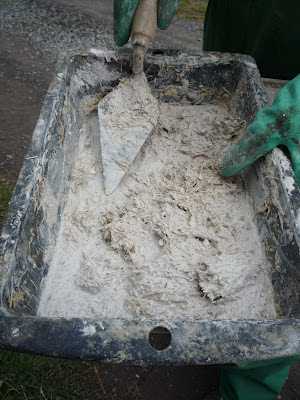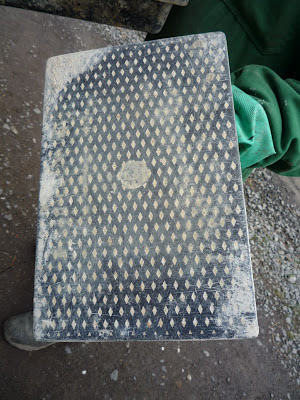The Cream of the Crop: Lovely Linen and Lime.
Understanding the material
Like all organic matter linen and hemp react to their environment so although there are some indications as to the quantities used to make up plaster, there are no actual hard and fast rules. When making up your mortar consideration should be made for several factors.
The moisture content in the air on the day you are using the plaster.
The movement of air both inside and out.
The particular batch of linen/hemp (I have never found two the same).
The grade of linen/hemp used. (see paragraph below)
The grade and type of lime used. (see below)
If you think this sounds complicated, it isn't. It is something you get to know instinctively the more you work with natural materials. If I can make an analogy, I might think of eggs. Most people, who don't keep hens, think that eggs come in uniform sizes, they don't, they just get graded that way commercially but on average a standard egg weighs 65g. Therefore in our case when we use our bantam eggs we weigh the eggs.
As a general rule these are the measurements we use:
For Hemp:
6kg lime
1kg hemp
6 litres water
Coverage about 1m² at approx 2cm thickness on an uneven wall
For Linen:
6kg lime
1kg linen
6 litres water
Coverage between 0.7 - 0.75m² at approx 1.5cm thickness on an uneven wall
Grades of fibres - Going green without getting into the Red
 You can find ecological wall covering, which is not designated as such, sold at a much cheaper price than that at a special Ecological Builders' Merchants. For example, the hemp we used was actually organic hemp mulch, sold mainly for organic horticulture. The linen was baled and sold for using in horse boxes. Our house is an old vernacular 18th Century farm and these grades of finish suit it. If you are thinking about your budget and using these materials in a less rural setting, then you can still economise by just using the finer grade of these materials as a final coat. As with most things it pays to shop around. The price of ecological materials is ever changing, as more farmers grow organic linen and hemp and as more people buy and use it, the price will begin to drop. In France the production of hemp is limited at the moment and thus the price, other than in mulch-grade, remains stable. However, when you consider that this is a one-off wall covering and that it is doing the double job of decoration and insulation and that above all it is giving you a healthy environment in which to live, it is worth paying the additional costs. Additionally if you are living in an old house, it overcomes the problem of what to do with the walls, which are often uneven and constructed of misshapen and unattractive stone. Furthermore, these stones were never meant to be seen but were yearly covered with a new coat of limewash. Houses like ours only ever had one window, a permanently lit fire, little through-draft and were kept even warmer by the sheer volume of life, both animal and human living within.
You can find ecological wall covering, which is not designated as such, sold at a much cheaper price than that at a special Ecological Builders' Merchants. For example, the hemp we used was actually organic hemp mulch, sold mainly for organic horticulture. The linen was baled and sold for using in horse boxes. Our house is an old vernacular 18th Century farm and these grades of finish suit it. If you are thinking about your budget and using these materials in a less rural setting, then you can still economise by just using the finer grade of these materials as a final coat. As with most things it pays to shop around. The price of ecological materials is ever changing, as more farmers grow organic linen and hemp and as more people buy and use it, the price will begin to drop. In France the production of hemp is limited at the moment and thus the price, other than in mulch-grade, remains stable. However, when you consider that this is a one-off wall covering and that it is doing the double job of decoration and insulation and that above all it is giving you a healthy environment in which to live, it is worth paying the additional costs. Additionally if you are living in an old house, it overcomes the problem of what to do with the walls, which are often uneven and constructed of misshapen and unattractive stone. Furthermore, these stones were never meant to be seen but were yearly covered with a new coat of limewash. Houses like ours only ever had one window, a permanently lit fire, little through-draft and were kept even warmer by the sheer volume of life, both animal and human living within.Lime
As already stated this house is of a vernacular rural nature and the 'roughcast' wall surface suits it admirably. We were doubly happy about this as neither of us wanted to use quicklime, which is dangerous stuff and makes a beautiful plaster, which keeps elastic for days and allows for the realisation of a smooth finish between batches. It was also used in the fine plastering on Church and manor walls to provide a surface ready for decoration with fresco. There is no reason not to use it if you feel confident about it but just be aware that it burns.
There are various grades of hydraulic lime which are available and we found NHL 3.5 both easily obtainable and fit for purpose.
Preparation
In order to maximize the coverage of expensive linen or hemp lime mixture, a lot can be saved by preparing the wall. This is also necessary for making a good solid surface for the plaster to adhere to. We firstly removed any loose materials between the stones of the Tiny House walls. This farm was built with clay and stone, clay being a very good natural insulation and mortar. We then pointed the joints with a lime mortar, made up of: six of sand to one of lime. We also rebuilt any of the areas which had lost stone, again thinking of costs, every bit helps!
Mixing and using the hemp or linen and lime plaster
Once we got used to the mix we used a cement mixer to make large batches of plaster but at the beginning we just mixed in a trug. Mix ingredients in this order: measured quantity of lime, slowly add water, mix in hemp or linen, leave to repose for approximately 10 minutes.
 Just a small amount I mixed as a demonstration. Note the use of thick protective gloves, as even hydrated lime is extremely aggressive to the skin. When removing lime from the bag, we also wore eye protection and a mask. We also wore the same protective gear when using the cement mixer as it is easy to inhale lime dust at the beginning of the mix and get splashed by lime before the hemp or linen are thoroughly mixed together.
Just a small amount I mixed as a demonstration. Note the use of thick protective gloves, as even hydrated lime is extremely aggressive to the skin. When removing lime from the bag, we also wore eye protection and a mask. We also wore the same protective gear when using the cement mixer as it is easy to inhale lime dust at the beginning of the mix and get splashed by lime before the hemp or linen are thoroughly mixed together.
Hard hats useful for low doors!
For getting the plaster onto the wall you can simply use your hands, or alternatively a plasterer's float. To create the natural textured finish and also to retain the maximum insulation do not over-work the medium once it is on the wall. Hemp plaster needs more initial pressure to get it to adhere to the wall and is therefore much harder to work with than linen.
The walls of the Tiny House finished. Any lines where the different days' work shows can be smoothed down with a wire brush. For this reason never work to a straight edge because otherwise it is much more difficult to hide the join. This is the one drawback of using hydrated lime, it has a much quicker drying time than aerated and on a hot day can be drying as you work!
When we first started thinking about renovating the main house we decided to start with what we had available. This was a large volume of straw, which had been left by the previous owner. Using a converted electric lawnmower, we cut the straw into short lengths and mixed it into the lime. Even after the first application on the North interior wall of the Kitchen (all we could get done before the onset of that Winter), we noticed an enormous difference in the warmth of the room. So if you can get hold of a suitable chopping machine and have access to organic straw, which at the moment here in France is 1 Euro a bale, it could make a very cheap and viable alternative to the above.
These plasters should not just be considered as purely wall insulation. Sue laid these floor tiles onto a 'raft' of linen and lime mixture, which in turn, we had laid on top of a gravel foundation. This insulated the floor and stopped the problem we had had with condensation forming on the previous concrete floor in the Summer.
Renovation on our house is on-going, here is a film on some recent lime mortar pointing I did up on the workshop. Up being the operative word...
Thanks for dropping by and if you enjoyed this article, please fell free to share it and do ask if you need any further information.
All the best,
Andy
© Andy Colley 2013
The walls of the Tiny House finished. Any lines where the different days' work shows can be smoothed down with a wire brush. For this reason never work to a straight edge because otherwise it is much more difficult to hide the join. This is the one drawback of using hydrated lime, it has a much quicker drying time than aerated and on a hot day can be drying as you work!
A final word about straw
When we first started thinking about renovating the main house we decided to start with what we had available. This was a large volume of straw, which had been left by the previous owner. Using a converted electric lawnmower, we cut the straw into short lengths and mixed it into the lime. Even after the first application on the North interior wall of the Kitchen (all we could get done before the onset of that Winter), we noticed an enormous difference in the warmth of the room. So if you can get hold of a suitable chopping machine and have access to organic straw, which at the moment here in France is 1 Euro a bale, it could make a very cheap and viable alternative to the above.
These plasters should not just be considered as purely wall insulation. Sue laid these floor tiles onto a 'raft' of linen and lime mixture, which in turn, we had laid on top of a gravel foundation. This insulated the floor and stopped the problem we had had with condensation forming on the previous concrete floor in the Summer.
Renovation on our house is on-going, here is a film on some recent lime mortar pointing I did up on the workshop. Up being the operative word...
Thanks for dropping by and if you enjoyed this article, please fell free to share it and do ask if you need any further information.
All the best,
Andy
© Andy Colley 2013

































